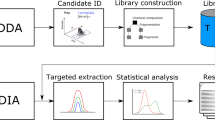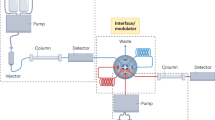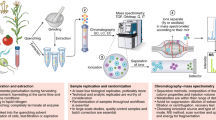Abstract
In the emerging field of metabolomics, there is an increasing need for improving sample derivatization reactions for gas chromatographic–mass spectral analysis of metabolites with large numbers of samples. This protocol details the safe direct derivatization of organic acids using diazomethane in a 96-sample format. Diazomethane is a highly reactive gas that readily forms methyl esters with carboxylic functionalities, with minimal side products or nonvolatile reaction residues. However, diazomethane's reactivity and explosive potential make it hazardous to store and work with. In this procedure, diazomethane is generated in situ and used concurrently to methylate up to 96 samples simultaneously, thus reducing concerns about reagent stability and obviating the need for storage of solutions of the highly reactive gas. Once the diazomethane generator has been assembled, processing 96 samples takes 2–3 h using this procedure.
This is a preview of subscription content, access via your institution
Access options
Subscribe to this journal
Receive 12 print issues and online access
$259.00 per year
only $21.58 per issue
Buy this article
- Purchase on Springer Link
- Instant access to full article PDF
Prices may be subject to local taxes which are calculated during checkout




Similar content being viewed by others
References
Monton, M.R. & Soga, T. Metabolome analysis by capillary electrophoresis-mass spectrometry. J. Chromatogr. A 1168, 237–246 discussion 236 (2007).
Fiehn, O. Extending the breadth of metabolite profiling by gas chromatography coupled to mass spectrometry. Trends Analyt. Chem. 27, 261–269 (2008).
Little, J.L. Artifacts in trimethylsilyl derivatization reactions and ways to avoid them. J. Chromatogr. A 844, 1–22 (1999).
Halket, J.M. et al. Chemical derivatization and mass spectral libraries in metabolic profiling by GC/MS and LC/MS/MS. J. Exp. Bot. 56, 219–243 (2005).
Wells, R.J. Recent advances in non-silylation derivatization techniques for gas chromatography. J. Chromatogr. A 843, 1–18 (1999).
von Pechmann, H. Ueber Diazomethan. Ber. Dtsch. Chem. Ges. 27, 1888–1891 (1894).
Cohen, J.D. Convenient apparatus for the generation of small amounts of diazomethane. J. Chromatogr. 303, 193–196 (1984).
De Boer, T.J. & Backer, H.J. Organic Syntheses, Collective Vol. IV (John Wiley & Sons, New York, 1963).
Proctor, L.D. & Warr, A.J. Development of a continuous process for the industrial generation of diazomethane. Organic Process Res. Dev. 6, 884–892 (2002).
Shaw, R. & Elliott, W.H. Bile acids. OV. 2,2-Dimethoxypropane: an esterifying agent preferred to diazomethane for chenodeoxycholic acid. J. Lipid Res. 19, 783–787 (1978).
Liebich, H.M. & Först, C. N-Methylation and N,N-dimethylation of amino acids. An artifact production in the analysis of organic acids using diazomethane as derivatizing agent. J. Chromatogr. 338, 33–40 (1985).
Campbell, J.A., Weimer, W.C., Chess, E.K. & Scully, F.E. Jr. Study of the reaction of diazomethane with dansylated amino acid derivatives by gas chromatography/mass spectrometry. Biol. Mass Spectrom. 19, 520–522 (1990).
Parks, G.S. & Mosher, H.P. Enthalpy and free energy changes in some simple polymerization processes. J. Polym. Sci. A 1, 1979–1984 (1963).
Steacie, E.W.R. The thermal decomposition of diazomethane. J. Phys. Chem. 35, 1493 (1931).
Little, J.L. Derivatization of carboxylic acids with diazomethane and trimethylsilyldiazomethane: convenient methods and artifacts. http://users.chartertn.net/slittle/files/diazoalkanes.pdf (accessed 9 August 2010).
Barkawi, L.S. et al. A high-throughput method for the quantitative analysis of indole-3-acetic acid and other auxins from plant tissue. Anal. Biochem. 372, 177–188 (2008).
Barkawi, L.S., Tam, Y.-Y., Tillman, J.A., Normanly, J. & Cohen, J.D. A high-throughput method for the quantitative analysis of auxins. Nat. Protoc. 5, 1609–1618 (2010).
Schlenk, H. & Gellerman, J.L. Esterification of fatty acids with diazomethane on a small scale. Anal. Chem. 32, 1412–1414 (1960).
Cohen, J.D. Convenient apparatus for the generation of small amounts of diazomethane. J. Chromatogr. 303, 193–196 (1984).
Krebs, K.G., Heusser, D. & Wimmer, H. Thin Layer Chromatography: A Laboratory Handbook, second edn. (Springer-Verlag, 1969).
Acknowledgements
We thank J. Normanly, A.Culler, W.-P. Chen and Y. Mohammed for help in trials of the diazomethane generator, and M. Emerick for help with metal design and fabrication. This work was supported by grants from the US National Science Foundation (DBI 0077769, DBI 0606666, MCB 0725149 and IOS 0923960) and the US Department of Agriculture National Research Initiative (2005-35318-16197).
Author information
Authors and Affiliations
Contributions
J.D.C. and L.S.B. conceived the protocol. The protocol is based on a previous diazomethane generator design by J.D.C. that he redesigned for higher flows and volumes. L.S.B. conducted the experiments, tested the protocol and wrote the paper with assistance from J.D.C.
Corresponding author
Ethics declarations
Competing interests
The authors declare no competing financial interests.
Rights and permissions
About this article
Cite this article
Barkawi, L., Cohen, J. A method for concurrent diazomethane synthesis and substrate methylation in a 96-sample format. Nat Protoc 5, 1619–1626 (2010). https://doi.org/10.1038/nprot.2010.119
Published:
Issue Date:
DOI: https://doi.org/10.1038/nprot.2010.119
This article is cited by
-
Indole-3-acetylaspartate and indole-3-acetylglutamate, the IAA-amide conjugates in the diploid strawberry achene, are hydrolyzed in growing seedlings
Planta (2019)
-
Lab-scale production of anhydrous diazomethane using membrane separation technology
Nature Protocols (2017)
-
Conversion of Indole-3-Butyric Acid to Indole-3-Acetic Acid in Shoot Tissue of Hazelnut (Corylus) and Elm (Ulmus)
Journal of Plant Growth Regulation (2016)
-
Protocol: High-throughput and quantitative assays of auxin and auxin precursors from minute tissue samples
Plant Methods (2012)
-
A high-throughput method for the quantitative analysis of auxins
Nature Protocols (2010)
Comments
By submitting a comment you agree to abide by our Terms and Community Guidelines. If you find something abusive or that does not comply with our terms or guidelines please flag it as inappropriate.



